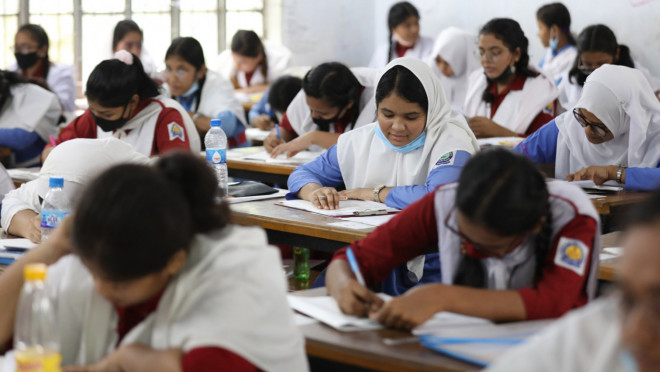Do this year’s SSC results mirror deeper flaws of our education system?
Do this year’s SSC results mirror deeper flaws of our education system?

Every year, the day the board exam results are published feels like a national celebration. Schools across the country burst into festivities, and sweet shops see a surge in sales. In contrast, the stories of students who fail often remain in the shadows.
However, this year, the publication of the Secondary School Certificate (SSC) exam results marks a shift, as the spotlight has turned towards those left in the shadows.
This year, the average pass rate stands at just 68.45%, a sharp drop from 83.03% last year. From a different angle, 134 institutions across the country recorded zero pass rates this year, up from 51 last year. The number of institutions with a 100% pass rate has also dropped by 1,984.
That’s just about the pass-fail numbers. But if we question the quality of education, even a glance at the GPA-5 statistics will leave us disappointed. A total of 139,032 students obtained GPA-5 this year, compared to 182,129 students last year.
We must question why almost one-third of the students could not even pass. So, is it that the result has revealed the true face of our education system that had long remained hidden?
The real picture?
Tariq Manzoor, Professor of Bangla at Dhaka University, noted that whether students pass or fail also depends on how examiners check the papers. In the past, they were told to mark more leniently, which increased the pass rate. This year, the results are worse mainly because the approach was changed.
It is true that, according to reports published in various newspapers, the evaluation of answer scripts was stricter this year compared to previous years. Even the chairmen of the education boards have admitted to journalists that they had no specific target to increase or decrease the pass rate.
Dr Mohammod Moninoor Roshid, professor at the Institute of Education and Research (IER), Dhaka University, also emphasised that one major factor behind the sharp drop is a shift in government policy in the evaluation process.
“The previous government aimed to boost public satisfaction by inflating SSC and HSC results, under the assumption that higher pass rates signalled educational success. Examiners were subtly guided to award marks generously, regardless of content,” he said.
“For the past 15 years, over-marking has become a norm for political reasons. This practice is exposed by the Dhaka University admission test, where nearly 90% of students fail. Many of those with ‘A+’ or ‘A’ grades simply didn’t deserve the grades,” he added.
The deeper roots
The root causes of this year’s failure run even deeper.
Bangladesh went through a major political change and faced serious unrest during the past one year. This may have caused anxiety and uncertainty, which could affect students’ motivation and performance. Although there is no direct study linking the two, it’s a strong hypothesis whatsoever.
Professor Tariq mentioned that the Covid-19 pandemic could also have a far-reaching impact on the results.
He explained, “The students who got their SSC results this year were in grades six and seven during the pandemic. These are the grades where students are first introduced to algebra. Since schools were closed at that time, students could not build a strong foundation and moved on to grade eight with significant learning gaps.”
Meanwhile, according to media reports, 14,738 students were absent on the first day and 28,943 on the second day during the exams. Under the Dhaka Education Board alone, 6,389 candidates were absent in this year’s SSC exams. Information collected from 1,203 of them reveals that nearly 40% got married. This marriage rate includes both girls and boys.
That covers those who registered but didn’t sit for the exams. But there’s a large number of students who didn’t even register in the first place. The number of registered students was nearly 100,000 fewer than last year. In fact, this year saw the lowest number of examinees in the past five years.
Dr Soma Dey, an Associate Professor in the Department of Women and Gender Studies at Dhaka University, believes that there is certainly a correlation between child marriage and education.
“When someone falls victim to child marriage, their education naturally gets disrupted. They shift their focus from studies to managing household responsibilities. In case of girls, they also go through complexities like pregnancy and child-rearing,” she said.
The way forward
Dr Soma Dey noted, “Instead of focusing on how to bring someone back into education after they have already been married off, we should focus on how to prevent child marriage.”
“Then again, if someone does end up in such a situation and wants to continue their education after marriage, we must support them as well. For that, there needs to be state initiatives and mechanisms in place,” she added.
However, the biggest question still remains—our definition of education and the metrics by which we measure success. Professor Tariq believes that traditional question patterns often fail to truly assess a student’s intellect.
“In modern education systems, the emphasis on factual questions has decreased. Information that can be found online within seconds doesn’t need to be tested through rote memorisation. Instead, exam questions should be designed to evaluate a student’s understanding, analytical ability, and originality,” he opined.
He added that we must not rush into new initiatives. Changes should be made with reasonable timeframes and only after assessing their effectiveness. For long-term planning, it is essential to bring together skilled and experienced individuals from the education sector.


